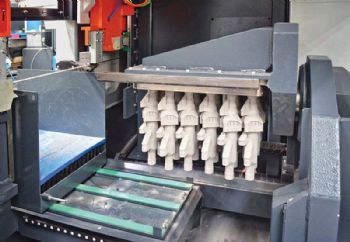
To save time, weight and costs when producing metal aircraft components, Airbus Helicopters in Donauwörth (Bavaria) — part of the Airbus Group and employing 7,000 people — has recently been using additive manufacturing.
The company develops and produces a range of helicopter models such as the H135 and H145; it also manufactures more than 4,000 doors for passenger and cargo aircraft every year.
To separate 3-D printed titanium parts from their base plate rapidly, economically and without damage, Airbus Helicopters bought an automatic KastoWin amc bandsaw in October 2018 (
www.kasto.com).
This machine, which is enclosed to prevent the ambient air from becoming contaminated, is configured for connection to an extraction system.
The Donauwörth factory additively manufactures titanium shafts (for locking aircraft doors) using the layer-by-layer powder-bed method.
These shafts have thin walls and a complex geometry; making them by 3-D printing cuts costs by 25% and weight by more than 45% — or 4kg per A350 aircraft, which uses 16 shafts.
When printing of the components is finished, they are separated from the 400 x 400mm titanium baseplate by the KastoWin amc, which was designed specifically for this operation.
The base plate with 3-D printed shafts (weighing up to 40kg) is transported from the printer to the saw by fork-lift truck and securely clamped.
The plate is ground flat after each build, so it becomes progressively thinner. Before sawing begins, its thickness is measured and entered into the job wizard of the saw’s CNC.
The bandsaw blade, actuated by a high-precision ballscrew drive, then moves precisely to the programmed height.
When cutting is complete, the shafts fall into a padded container (to prevent damage) and are removed through a flap.